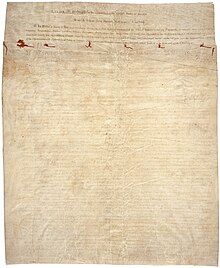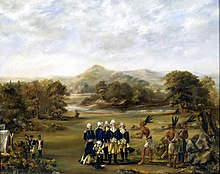Treaty of Greenville: Difference between revisions
12.17.54.68 (talk) No edit summary Tag: Removal of interwiki link; Wikidata is live |
|||
| Line 51: | Line 51: | ||
[[Category:United States and Native American treaties|Greenville]] |
[[Category:United States and Native American treaties|Greenville]] |
||
[[Category:Greenville, Ohio]] |
[[Category:Greenville, Ohio]] |
||
[[de:Vertrag von Greenville]] |
|||
[[fr:Traité de Greenville]] |
|||
[[it:Trattato di Greenville]] |
|||
[[pl:Traktat z Greenville]] |
|||
[[pt:Tratado de Greenville]] |
|||
[[ru:Гринвилльский договор]] |
|||
Revision as of 20:33, 12 November 2012

The Treaty of Greenville was signed at Fort Greenville (now Greenville, Ohio), on August 3, 1795, between a coalition of American Indian tribes, known as the Western Confederacy, and frontiermen of the United States; it followed the Native American loss at the Battle of Fallen Timbers the previous year. The treaty ended the Northwest Indian War in Ohio Country.
The United States was represented by General "Mad Anthony" Wayne, who led the victory at Fallen Timbers. In exchange for goods to the value of $20,000 (such as blankets, utensils, and domestic animals), the American Indian tribes ceded to the United States large parts of modern-day Ohio, the future site of downtown Chicago,[nb 1][2] the Fort Detroit area, Maumee, Ohio Area,[3] and the Lower Sandusky Ohio Area.[4]

American Indian leaders who signed the treaty included leaders of these bands and tribes:
- Wyandot
- Delaware (Lenape; several bands)
- Shawnee
- Ottawa (several bands)
- Chippewa
- Potawatomi (several bands)
- Miami (several bands)
- Wea
- Kickapoo
- Kaskaskia

The treaty established what became known as the "Greenville Treaty Line," which was for several years a boundary between American Indian territory and lands open to European-American settlers. The latter frequently disregarded the treaty line as they continued to encroach on native lands guaranteed by the treaty. The treaty line began at the mouth of the Cuyahoga River in present-day Cleveland and ran south along the river to the portage between the Cuyahoga and Tuscarawas River, in what is now known as the Portage Lakes area between Akron and Canton. The line continued down the Tuscarawas to Fort Laurens near present-day Bolivar. From there, the line ran west-southwest to near present-day Fort Loramie on a branch of the Great Miami River. From there, the line ran west-northwest to Fort Recovery, on the Wabash River near the present-day boundary between Ohio and Indiana. From Fort Recovery, the line ran south-southwest to the Ohio River at a point opposite the mouth of the Kentucky River in present-day Carrollton, Kentucky.
William Clark of the Lewis and Clark Expedition was present at Greenville. Years later he met again one of the Delaware chiefs from the conference, and noted in his journal for December 23, 1803: "a raney [sic] day… several Deleaway pass, a chief whome I saw at Greenville Treaty, I gave him a bottle of whiskey."[7]


The treaty also established the "annuity" system: yearly grants of federal money and supplies of calico cloth to American Indian tribes. It institutionalized continuing government influence in tribal affairs and gave outsiders considerable control over American Indian life.[8]
Nearly twenty years later, on July 22, 1814 General William Henry Harrison and Governor Lewis Cass held a second treaty signing at Greenville, with the Wyandot, Delaware, Shawnee, Seneca, Miami and Potawatomi tribes.[9] That treaty brought support from those tribes for the US during the War of 1812.
Notes
References
- ^ Charles J. Kappler (1904). "TREATY WITH THE WYANDOT, ETC., 1795". U.S. Government treaties with American Indian tribes. Oklahoma State University Library. Retrieved 1 August 2009.
- ^ "Fort Dearborn" in online Encyclopedia of Chicago accessed 2009-08-01
- ^ see Article 3 #8
- ^ see Article 3 #11
- ^ Furlong, William Rea; McCandless, Byron (1981). So Proudly We Hail : The History of the United States Flag. Washington, D.C.: Smithsonian Institution Press. p. 160. ISBN 0-87474-448-2.
- ^ Anthony Wayne Flag (Greenville Treaty Flag)
- ^ G. Moulton, ed. The Journals of the Lewis and Clark Expedition. Vol. 2, p. 140.
- ^ Eric Foner, Give Me Liberty
- ^ [1]
